With the Infrastructure Investment and Jobs Act passing in 2022, large commercial and municipal construction is anticipated to boom throughout 2023 and beyond. The global truck-mounted crane market is expected to be valued at nearly $3.8 billion by 2032.
Many construction jobs, whether residential, commercial, or industrial, cannot be performed without the powerful lifting capabilities of truck cranes. Two popular solutions for lifting heavy cargo around job sites are hydraulic truck cranes and boom trucks.
Truck cranes are large vehicles that transport a hydraulic truck crane for lifting purposes. Boom trucks are simply commercial vehicles, commonly flatbed trucks, with a hydraulic crane attached.
This article will home in on the difference between hydraulic truck cranes and boom trucks to help you decide what type of crane is best for your job site. You may even come across some new terminology along the way — it helps to be familiar with the latest machinery and equipment to keep up with increasing construction demand.
What Is A Hydraulic Truck Crane and How Does It Work?
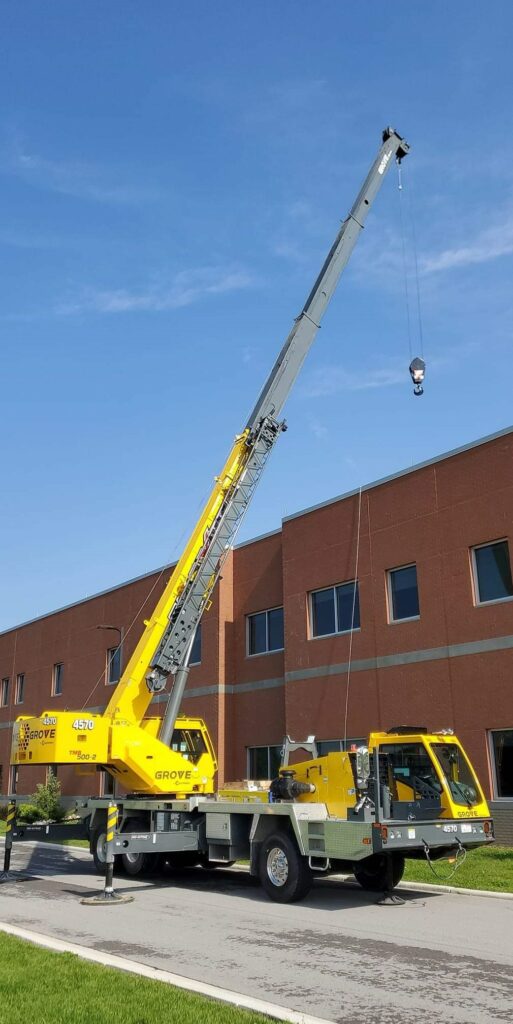
Hydraulic truck cranes are one of the most popular modern-day lifting machines for construction job sites. Hydraulic truck cranes use an internal hydraulic system to lift heavy items around a job site. They are made up of an enclosed cab for the operator, a steel base, and a long telescopic boom that can be articulated or fixed in position, depending on the job.
These massive lifting vehicles weigh about 67,527 pounds on average and have different load capacities depending on their weight. A 75-ton crane can handle approximately 10,800 pounds, while a 100-ton crane can lift roughly 32,500 pounds. Hydraulic truck cranes can lift equipment on job sites that are generally too heavy for other lifting equipment.
How Do Hydraulic Truck Cranes Work?
Hydraulic truck cranes use pressurized fluids, usually oil, with a pump system that generates the lifting power needed to pick up loads. There are two types of pumps a hydraulic crane truck can use:
- Gear pumps: These are the standard pump systems for most economical models. They consist of interlocking gears that displace the oil as the engine speeds up. Running the engine at full power is the only way to achieve high pressure.
- Variable-displacement pumps: These pumps are a more advanced pump system consisting of multiple piston cylinders. The piston cylinders are connected to a ring inside a barrel attached to a swashplate. To generate the needed pressure, the barrel spins, and the swashplate pushes and pulls the pistons in and out of the cylinder, drawing oil into the hydraulic system.
What Jobs Are Hydraulic Truck Cranes Good For?
Hydraulic truck cranes perform tasks impossible for humans alone. They are strong enough to lift concrete blocks, bricks, metal frames, or even other cranes and construction equipment.
While hydraulic cranes are commonly used for residential, civil, or commercial construction jobs, they are also highly requested and applicable in other unique settings. Businesses or contractors that need to move shipping cargo containers, vehicles, or even large animals can benefit from the incredible lifting power of hydraulic truck cranes. Drive by any airport, bridge, railway, stadium, hotel, apartment complex, or mall under construction, and chances are you will see a hydraulic truck crane on site.
Although mighty, these cranes are simple, easy to maintain, and quick to set up. Their mobility makes them flexible, versatile, and more convenient and compact than stationary cranes. Even though they weigh more than 67,000 pounds, hydraulic truck cranes are lightweight when compared to some larger, less powerful cranes.
What Is a Boom Truck and How Does It Work?
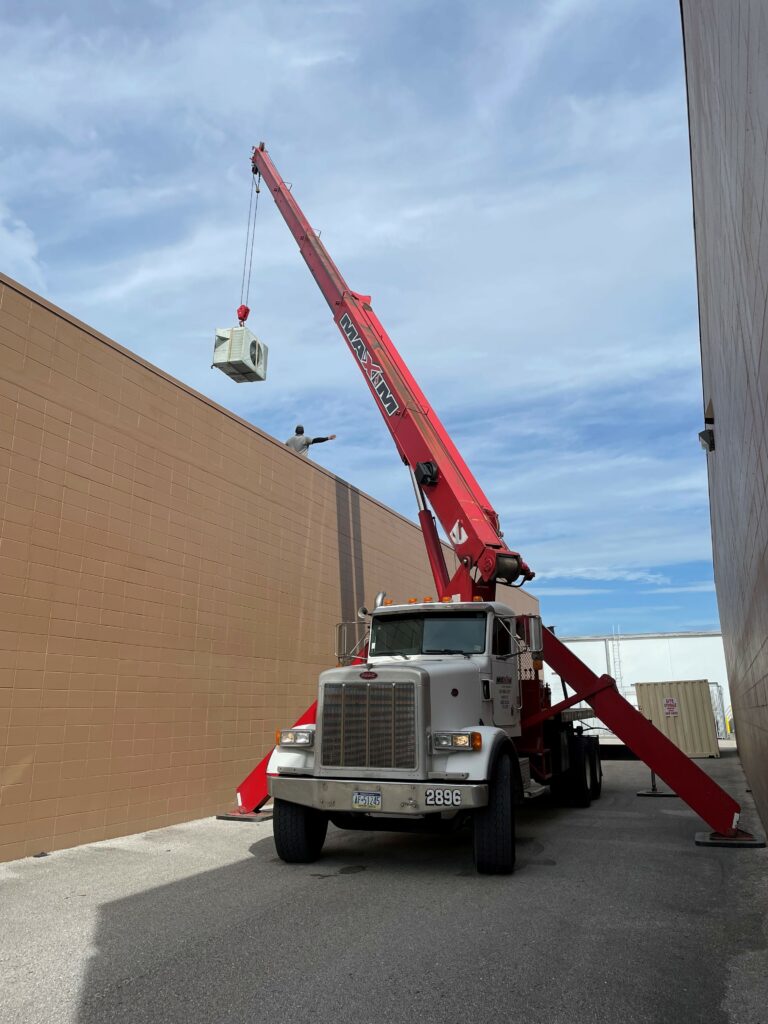
Now let’s dive into another type of hydraulic truck crane. A boom truck is a hydraulic crane mounted on a commercial truck chassis, meaning a range of vehicles can be referred to as boom trucks.
Boom trucks cannot lift loads as heavy as those hydraulic crane trucks handle, but they are extremely popular among various industries today because of their mobility. Since boom trucks are less heavy-duty, they can move about job sites faster and easier than crane trucks.
Boom trucks drive like regular trucks and can travel freely on public roads, moving between job sites quickly and efficiently.
There are several different types of boom trucks, but all of them will have a hydraulic crane mounted to a heavy-duty vehicle with a winch capable of lifting heavy loads and a flatbed for transporting materials around job sites.
Modern-day boom trucks usually allow operators to reach 160 to 180 feet, and they can lift approximately 54 tons. Boom trucks can have their crane mounted over the rear axle, on a fifth-wheel tractor, to the rear of a flatbed truck, or on a truck chassis.
Boom trucks are popular because of their mobility and versatility. Here are the two most common types of boom trucks:
- Fixed cab: These boom trucks have a fixed cabin stationed permanently in one direction. Fixed cab boom trucks are very common but are limited in capabilities due to the stationary cab.
- Swing cab: A swing cab boom truck has a cabin that moves and rotates along with the boom. Swing cabs tend to be more adaptable than fixed cab boom trucks.
How Do Boom Trucks Work?
Boom trucks work via a few main components. As mentioned above, the boom is the lifting arm of the crane. Sliding parts allow the crane to extend and compress in order to create the appropriate space to lift and transport loads. The elevating cylinder is the hydraulic arm that raises and lowers the boom.
The cab, usually a flatbed truck, is where the operator controls the vehicle and boom movement. Lastly, the crane will have an outrigger. This retractable arm can extend from the side of the boom truck to stabilize and support the vehicle as it lifts a load. Outriggers keep the truck from moving while the crane is in use.
What Jobs Are Boom Trucks Good For?
Because of their high level of maneuverability, boom trucks are great for contractors who need to lift loads weighing less than 54 tons. Boom trucks can also drive right down freeways like regular vehicles, making them more practical.
Boom trucks are diverse and can help in many industries and job sites. Construction of buildings, roads, or other structures often uses boom trucks for a range of jobs, such as transporting heavy materials or lifting contractors to high locations.
Similarly, utility companies will use boom trucks to repair power lines or poles after damages inflicted by storms, natural disasters, or other harsh weather. Since HVAC systems are often on the roofs of large buildings, many HVAC companies will use boom trucks to lift heavy heating and cooling systems.
Compare: Which Is Best for Your Project?
Both hydraulic truck cranes and boom trucks are staples in the construction industry. Modern technology and design have come a long way over the years, and each is versatile and applicable to many different job sites. To best decide which option is best for your job, first understand the key benefits of both.
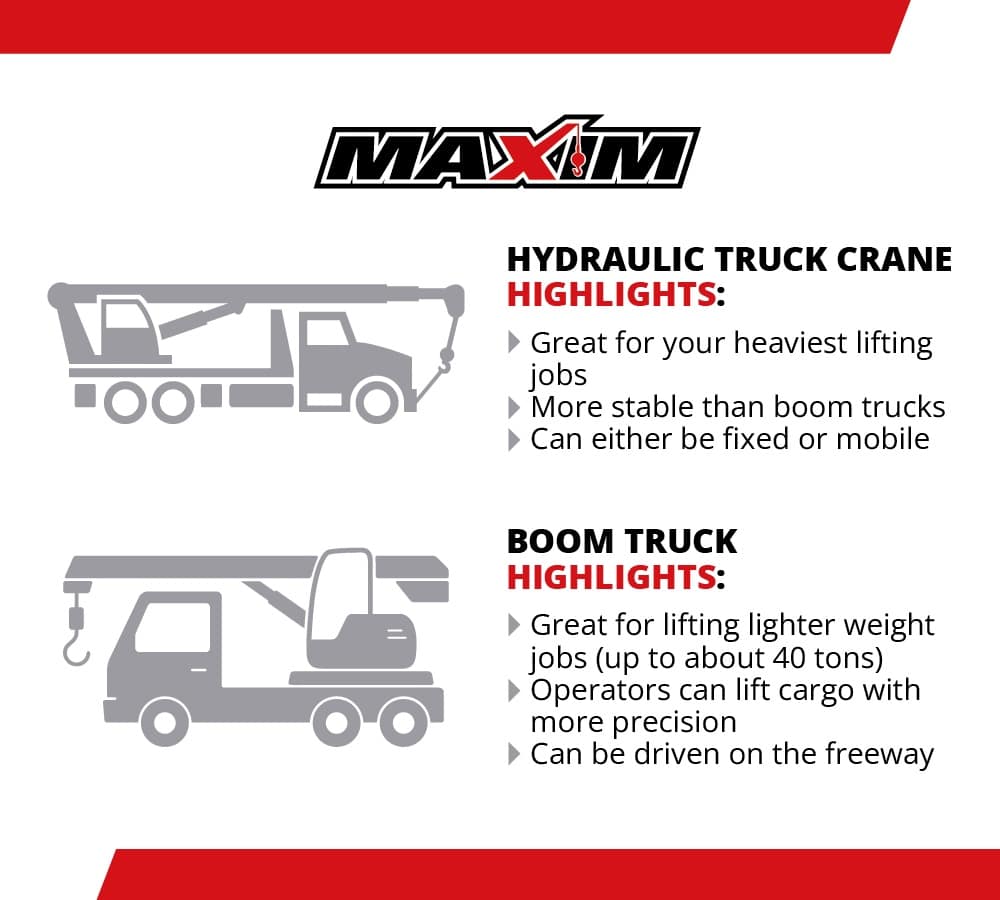
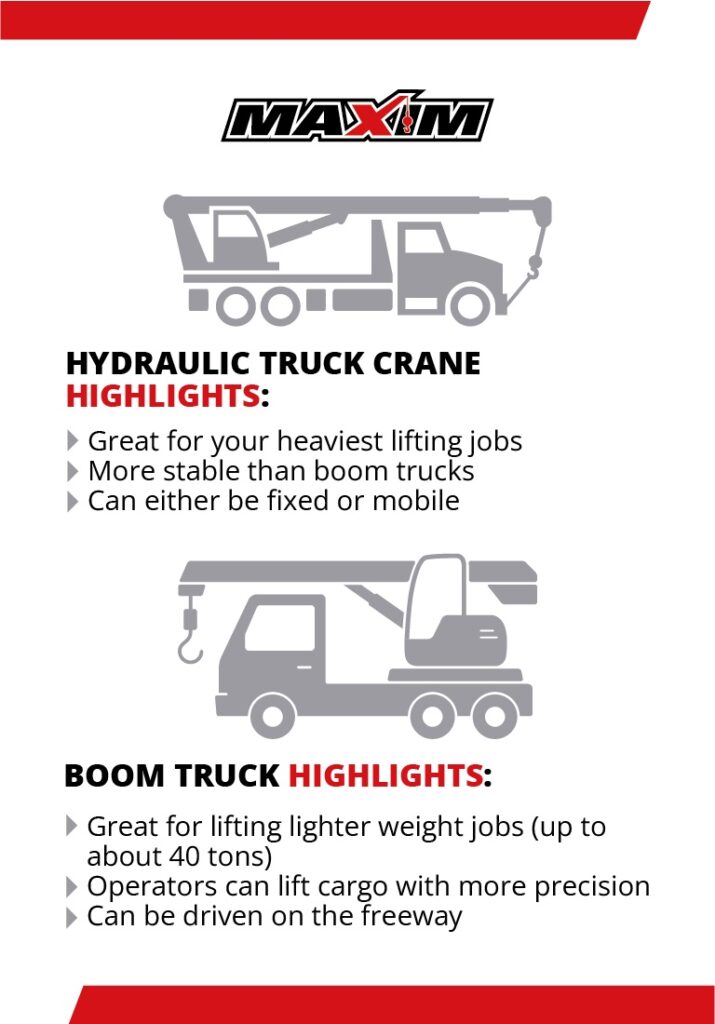
Boom trucks aren’t ideal for jobs needing to lift more than roughly 54 tons or job sites on rough terrain. You should look into all-terrain or rough-terrain cranes for the best reliability and safety on job sites with uneven terrain.
When deciding whether to use a boom truck or a hydraulic truck crane, ask yourself a few questions, keeping in mind the strengths and limitations of both options:
- What will you be lifting, and how heavy is it?
- What are the physical obstacles present on the job site to navigate around?
- What is the radius required for the lift?
- How high and far back does the item need to be lifted?
- Do I need to relocate the crane between job sites?
- Do I have qualified operators on staff?
Cut Costs by Renting a Crane for Your Next Project
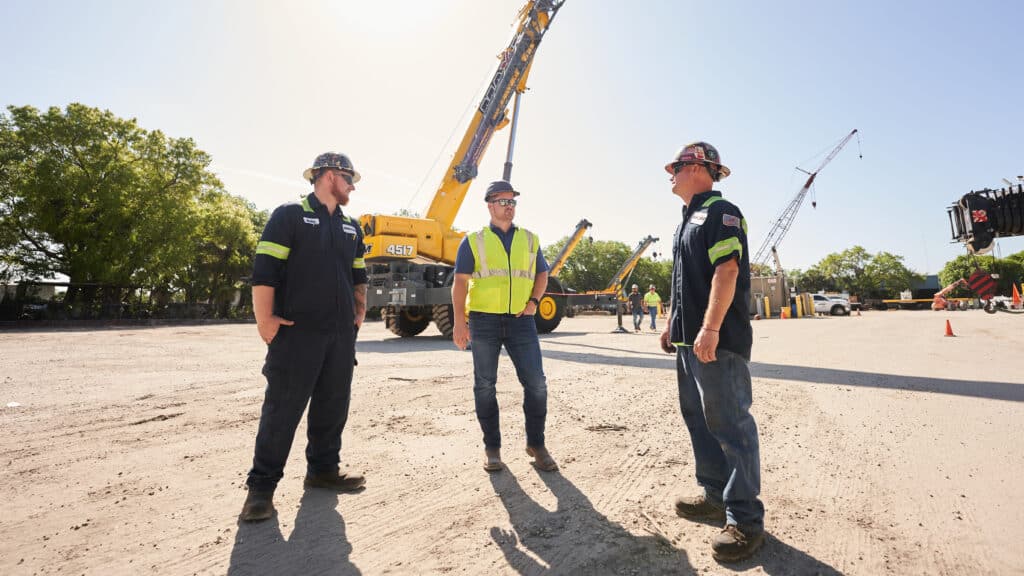
Owning and maintaining this equipment is no easy (or cheap) feat, and many contractors choose to rent cranes and lifting equipment from reputable companies to avoid mishaps. When you choose to rent cranes or boom trucks (with the exception of bare rentals), you won’t have to purchase insurance on the truck or obtain a government certification. If you rent equipment with an operator it saves you the cost of hiring or paying to license your current operators.
Renting equipment also means you won’t have expensive vehicles sitting idle when construction demand drops.
In today’s unpredictable economy and marketplace, renting equipment when you need it can be more convenient than purchasing it on your own. With more than 84 years of industry experience and the largest modern fleet of mobile cranes for rent globally, Maxim can answer all of your questions about renting lifting equipment. Their complete services and inventory of more than 3,000 cranes can help you implement a safe, effective, and efficient lift plan. Submit a crane rental inquiry, or check out Maxim’s rental services to learn more.



